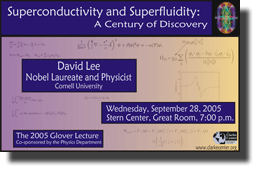Wednesday, September 28, 2005
Superconductivity and Superfluidity: A Century of Discovery
Stern Center, Great Room 7:00 P.M.
Issue in Context
As gases such as nitrogen or oxygen are cooled down further and further, they will at one point become liquids with similar traits to water. Helium is unique because, as it is cooled down even further, it develops some quirky qualities. For example, in extremely low temperatures, the “superfluid†helium can crawl through the tiniest of holes without any resistance and, given the chance, will crawl up and around the sides of any container.
These superfluids are reminiscent of superconductors, which have no electrical resistance. In theory, superfluids and superconductors both present novel concepts for future technologies. Physicists call these exotic states of matter “macroscopic quantum states.â€
What discoveries have been made in the fields of superfluidity and superconductivity over the past century? What philosophical implications do they have? What implications might they have for future technologies? The lecture will explore these and other important questions facing the field.
About the Speaker
David Lee has enjoyed an expansive and distinguished career in the field of low-temperature physics. With his colleagues Douglas D. Osheroff and Robert C. Richardson, he has spent the past decades making discovery after discovery in the field of superfluidity. In 1976, he and his colleagues received their first recognition for advances in superfluidity with the Simon Memorial Prize of the British Physical Society. In 1981, the group received the Buckley Prize of the American Physical Society. Finally, in 1996, the three shared the Nobel Prize in Physics.
Lee was elected a Fellow of the American Academy of Arts and Sciences in 1990 and a Member of the National Academy of Sciences in 1991. He was elected a Fellow of the American Physical Society and of the American Association for the Advancement of Science, both in 1982. He is currently a professor of physics at Cornell University and he earned his Ph.D. in physics in 1959 from Yale University.
